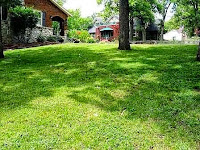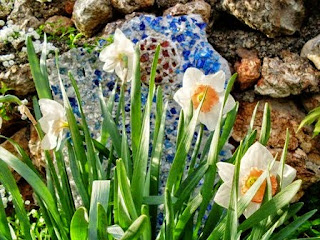 |
Keep cats out of your yard and garden by using humane methods rather than acts of cruelty.
A few years ago a client of mine was having problems with neighborhood cats that would enter her yard during the night and lounge on her patio furniture, use her plant containers as a litter box and mark her flower gardens. Needless to say my client had had it with the cats and was ready to kill them.
I offered my pest control services to remove the cats from her property without harming a hair on their furry little heads and she accepted my contract.
A few years ago a client of mine was having problems with neighborhood cats that would enter her yard during the night and lounge on her patio furniture, use her plant containers as a litter box and mark her flower gardens. Needless to say my client had had it with the cats and was ready to kill them.
I offered my pest control services to remove the cats from her property without harming a hair on their furry little heads and she accepted my contract.
 |
| Stray cat on Deck Image by Sgolis |
In order to permanently remove the neighborhood cats from the yard I needed to determine why they cats marked her yard as their territory.
I took a journal and walked through her entire yard and discovered that my client’s yard was a cat habitat.
There was overgrown shrubs with clumps of blue fescue ornamental grass that would provide shelter and bedding for the cats. Her deck also provided protection as it was in a location where the wind was blocked and the cats could get under the deck to set up house. Her yard was a cat sanctuary as it had shelter, reliable water source, and food source from the pet bowl that was left out overnight.
that would provide shelter and bedding for the cats. Her deck also provided protection as it was in a location where the wind was blocked and the cats could get under the deck to set up house. Her yard was a cat sanctuary as it had shelter, reliable water source, and food source from the pet bowl that was left out overnight.
I took a journal and walked through her entire yard and discovered that my client’s yard was a cat habitat.
There was overgrown shrubs with clumps of blue fescue ornamental grass
I made a note of the tasks that needed to be completed. I was certain that if I manicured her yard by pruning shrubs, low hanging tree branches and cutting back the brush it would deter many cats. My plan was simple; I would make her yard and gardens uninviting and I would remove the food source.
Make your yard unappealing to cats by manicuring your lawn, garden and pruning shrubs.
Remove all of the brush and you will remove the comfortable hiding places.
Purchase poultry netting
Apply mulch on top of the chicken wire. This method is affective because when cats go to dig for a place to their business the wire will annoy them. Cats do not like walking on chicken wire and after a few tries they will learn that this area is off limits.
Remove the food source by feeding pets indoors and emptying the water bowl at night. If you have a water fountain, shut it off at night so there is no running water. If you have a small pond, spread a large layer of chicken wire across the top of the pond and secure the wire with hooked stakes
The idea is to prevent the cats from getting to your water source or foraging from your pond. Koi fish will attract cats to your yard. A hungry cat will move to another location when food source in eliminated.
 |
| Peppermint plant |
Grow herbs that naturally repel cats. I found that peppermint, spearmint, lemongrass, geranium, rue, lavender, garlic, onions and thyme are plants that emit a scent that is revolting to cats.
Cats tend to avoid the areas in the yard where these herbs grow. For an effective barrier you would need to grow these plants in several areas of your yard. The idea is make the cats uncomfortable.
Choose a sunny location and plant a representation of these herbs. You may want to grow them along the fence, in the same location where the cats generally enter your yard. You may also want to grow these herbs in containers and set them close to your patio or outdoor living space. These fragrant herbs are an effective method for keeping cats out of your yard.
Cats tend to avoid the areas in the yard where these herbs grow. For an effective barrier you would need to grow these plants in several areas of your yard. The idea is make the cats uncomfortable.
Choose a sunny location and plant a representation of these herbs. You may want to grow them along the fence, in the same location where the cats generally enter your yard. You may also want to grow these herbs in containers and set them close to your patio or outdoor living space. These fragrant herbs are an effective method for keeping cats out of your yard.
Keep cats out of your yard by marking your yard and gardens with Shake Away Cat Repellent Coyote/Fox Urine . If you treat the perimeter of your yard with the shake away for cats they will pick up the scent and will avoid your yard. However not all cats are afraid of predator urine. Many housecats do not have the sense of scent and thus do not fear the scent of fox or coyote.
. If you treat the perimeter of your yard with the shake away for cats they will pick up the scent and will avoid your yard. However not all cats are afraid of predator urine. Many housecats do not have the sense of scent and thus do not fear the scent of fox or coyote.
I have used this product and it has proven to be useful in repelling feral and woodland cats. The best way to apply this product is to use it sparingly in yard and garden. Shake the granular treatment on the shrubs, trees, fence post, a container, or anywhere that a coyote of fox would mark. I apply the shake-away by marking a barrier around my yard. The product is effective as long as it does not get wet.
 |
| Cats keep cool on brick patio: Image Sgolis |
This cat prevention is easy to install and it gets the job done. Cats are afraid of water and when the cat comes within 1000 feet of the scarecrow the cat gets wet.
The scarecrow water sprinkler
This product needs to be at least three feet off the ground. You can mount on garden stake, the side of your garage, tree or fence post. The high frequency alarm is a good way to stop cats from marking or hanging out in your yard and garden. This product works as long as you put them in the right location and have enough alarms to provide protection for your entire yard. You may need two in the backyard and one in the front yard.
Tips:
- Before you implement any cat deterrents it is best to determine if the cats hanging out in your yard are stray, feral or house cats. If you have cats frequenting you yard I would suggest that you ask your neighbors if they know of the owner of the cat or cats that are camping out in your yard.
- I find the best way to remove cats from your yard is to make your yard uncomfortable and not welcoming to cats.
- I did not block the entrance under the deck because of the life factor. A cat could be hiding under the deck and I would have no way of knowing.
- If you suspect a cat is living under your deck you may want to set up a trap to catch the cat and then release the cat away from your yard or surrender to a no kill shelter.
Warning:
- Never attempt to crawl under a deck, there may be a raccoon or feral cat living there and they could attack you. If you are bitten you will need to undergo rabies treatment.
- Many people repel stray cats with mothballs. This repellent is toxic to cats. If the cats should touch the mothball with their paw and then lick their paw the cat will become seriously ill; vomiting, abdominal pain, organ failure, swelling of the brain, seizures, coma and death. This is not a humane way of repelling cats.



